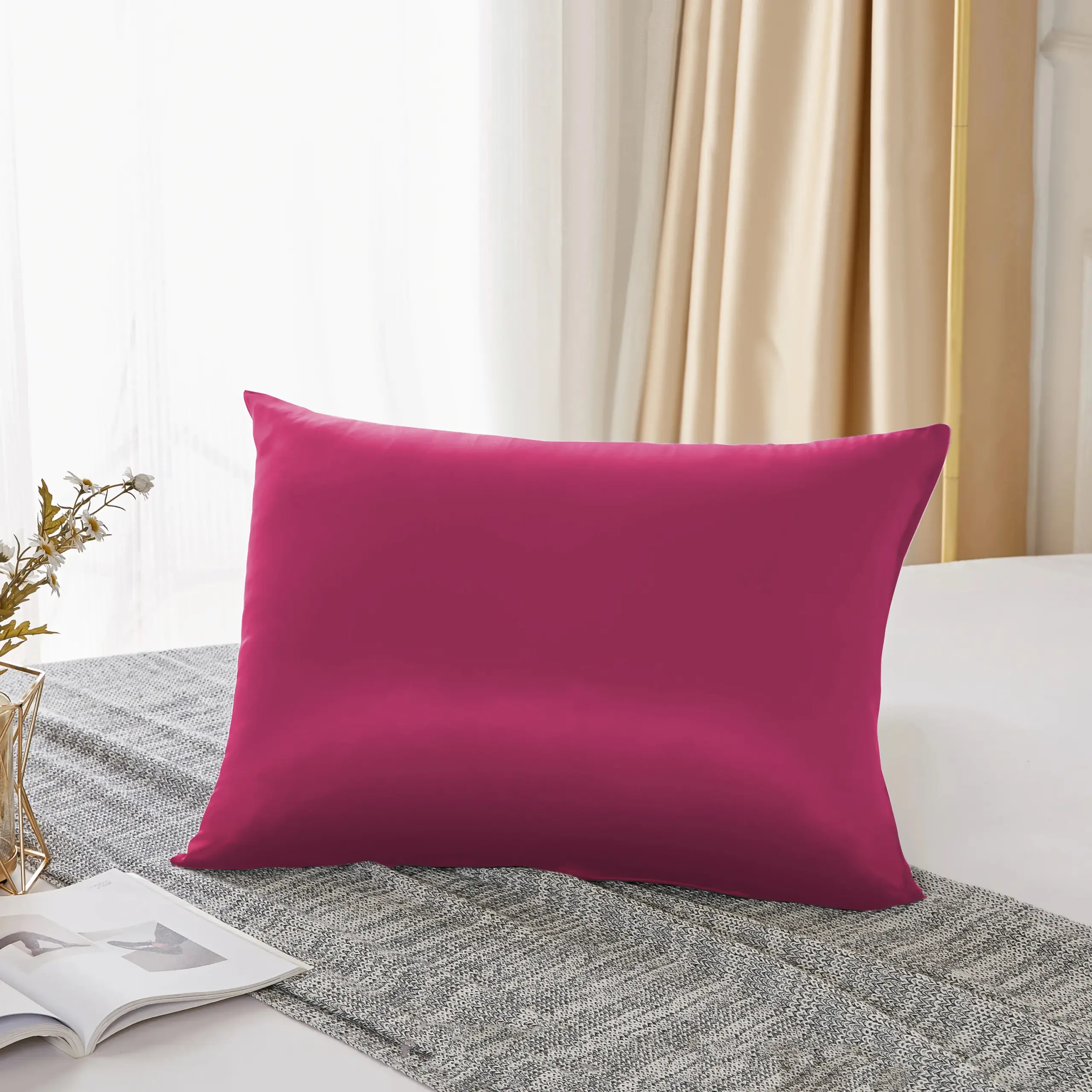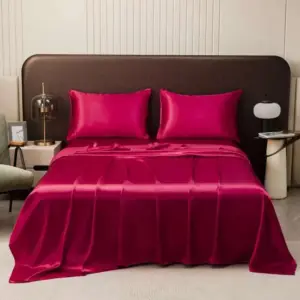Introduction: Understanding Sensitive Skin and Natural Silk’s Benefits
Sensitive skin isn’t just a minor inconvenience—it’s a daily challenge for millions of people. Characterized by redness, irritation, and heightened reactivity to environmental triggers, sensitive skin affects approximately 60-70% of women and 50-60% of men worldwide. This condition can be triggered by numerous factors, with fabric choice being one of the most significant yet often overlooked contributors.
The materials that touch our skin for hours each day play a crucial role in either soothing or aggravating sensitivity issues. Rough textures, chemical treatments, and poor breathability in common fabrics can all spark inflammation, itching, and discomfort for those with reactive skin.
Natural silk stands apart as a premium solution with remarkable properties specifically beneficial for sensitive skin. For over 5,000 years, this luxurious fabric has been treasured not only for its beauty but also for its medicinal properties. The secret lies in silk’s unique protein structure—composed primarily of fibroin and sericin proteins—which creates an exceptionally smooth, hypoallergenic surface that works in harmony with sensitive skin.
Understanding the hypoallergenic properties of silk fabric helps explain why dermatologists often recommend it for patients with various skin sensitivities. Throughout this article, we’ll explore the five key properties that make natural silk the ultimate fabric choice for those with sensitive skin.
What Makes Natural Silk Unique: Composition and Structure
Natural silk begins its journey in the cocoon of the Bombyx mori silkworm, where these remarkable creatures spin fibers to create their protective homes. Traditional silk production involves carefully unwinding these cocoons to harvest continuous filaments that can stretch up to 1,000 yards in length.
This extraordinary material derives its unique properties from its distinctive protein composition:
- Fibroin (70-80%): The core structural protein that gives silk its strength and lustrous appearance
- Sericin (20-30%): A natural gum-like protein that bonds the fibroin fibers together
At the molecular level, silk’s protein chains are arranged in a tight, crystalline structure that creates both remarkable strength and incredible softness. These tight protein chains contain amino acids that are similar to those found in human skin, which partially explains silk’s remarkable biocompatibility.
High-quality natural silk differs significantly from artificial alternatives and blends. Pure natural silk versus alternative fabrics shows marked differences in both feel and function. When shopping for silk products, quality is measured in “momme weight” (similar to thread count), with 19-25 momme being the optimal range for bedding that balances luxurious feel with durability.
For those with sensitive skin, the highest quality options are often found in mulberry silk pillowcases, which are made from silk produced by worms fed exclusively on mulberry leaves, resulting in the finest, most uniform fibers available.
1. Exceptional Smoothness: The Foundation of Skin Comfort
The exceptional smoothness of silk provides the foundation for its skin-friendly properties. At a microscopic level, silk fibers measure approximately 11 microns in diameter, compared to cotton’s relatively coarse 20 microns. This fundamental difference creates a surface that glides against skin rather than catching or pulling.
This smoothness directly translates to reduced friction—a critical factor for sensitive skin. While cotton and other fabrics create micro-friction with every movement, silk’s polished surface minimizes this mechanical irritation. For facial skin especially, this means fewer “sleep creases” and significantly reduced pulling or tugging that can aggravate sensitivity.
The practical impact becomes clear when comparing how different fabrics interact with skin during the 7-9 hours of continuous contact during sleep. Studies measuring friction coefficients show silk creates 43% less friction against skin than cotton, effectively reducing a major trigger for inflammation and irritation.
Many dermatologists recommend silk specifically for this property, as research consistently shows silk is good for sensitive skin by preventing the micro-abrasions that can trigger inflammation cycles. This is particularly valuable for conditions like rosacea or eczema where even minor friction can spark significant flare-ups.
2. Hypoallergenic and Antimicrobial Properties: Nature’s Protective Shield
True hypoallergenic fabrics must resist common allergens while avoiding the introduction of new irritants—a balance that silk achieves naturally. Unlike many synthetic “hypoallergenic” materials that rely on chemical treatments, silk’s protective qualities come from its inherent structure and composition.
Natural silk offers remarkable resistance to common allergens through several mechanisms:
- Dust mite resistance: Studies show silk fabric harbors 16-60% fewer dust mites than cotton, reducing a major trigger for allergic reactions
- Mold and fungal resistance: Silk’s naturally low moisture retention prevents the damp conditions these allergens need to thrive
- Bacterial resistance: The tight protein structure of silk provides fewer hiding places for bacteria compared to looped fibers in fabrics like cotton
These protective properties create a cleaner sleep environment with fewer potential irritants. The science behind silk’s hypoallergenic nature includes naturally occurring substances within the fiber that inhibit microbial growth without added chemicals or treatments.
For sensitive skin sufferers, this means waking up with less redness, fewer breakouts, and reduced allergic reactions. Many users find that switching to silk pillowcases provides immediate relief from morning facial irritation and helps maintain clearer skin over time.
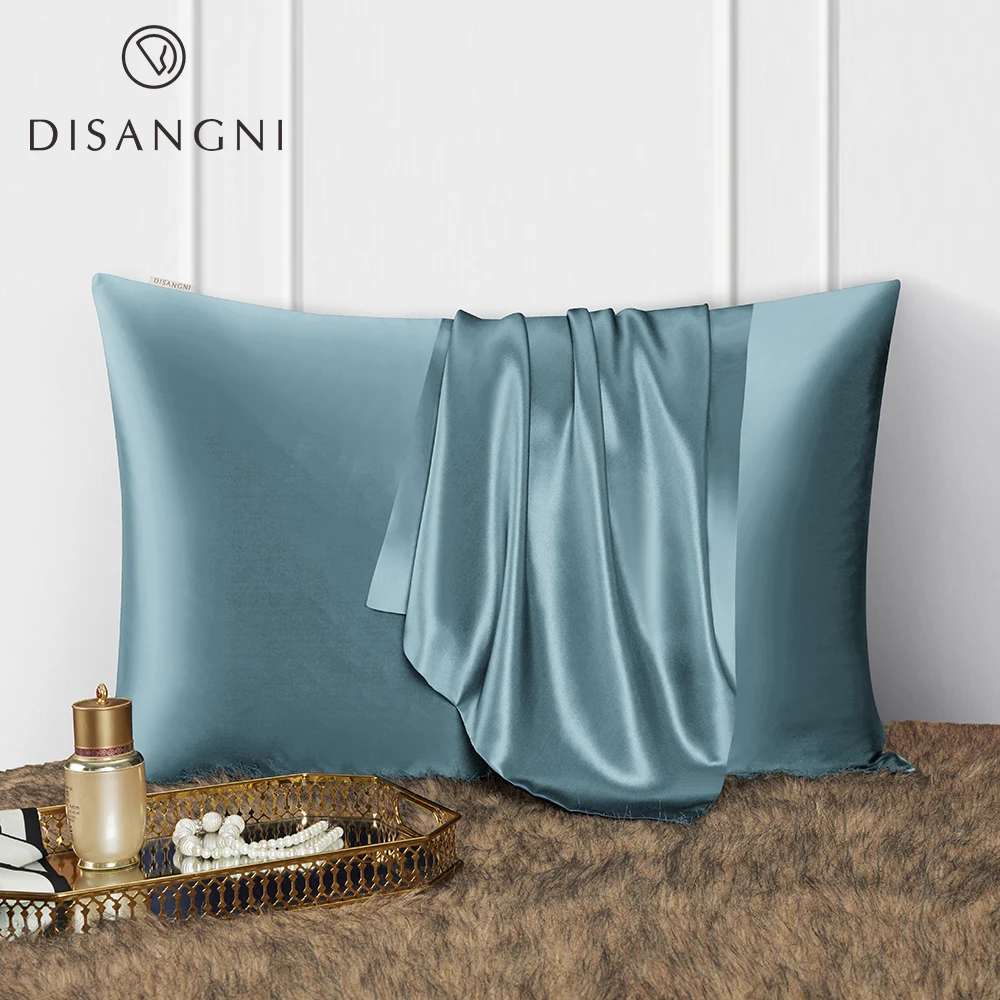
3. Optimal Moisture Regulation: Balancing Skin Hydration
Silk possesses a remarkable ability to manage moisture in a way that perfectly complements sensitive skin’s needs. While highly absorbent fabrics like cotton can draw essential moisture away from skin, silk maintains balance through selective moisture-wicking properties.
Natural silk can absorb up to 30% of its weight in moisture without feeling damp against the skin. This optimal level of absorption means it removes excess sweat while preserving the skin’s natural hydration balance. For sensitive skin, this balanced approach helps maintain the critical moisture barrier that prevents irritation and reactivity.
Another significant advantage is silk’s ability to preserve applied skincare products. While cotton and other absorbent fabrics can soak up expensive serums and moisturizers, silk allows these products to remain on the skin where they belong. This is particularly beneficial for dry or dehydrated sensitive skin that requires consistent moisture support.
For those with allergies and skin sensitivities, silk bedding for allergy sufferers offers dual benefits of moisture control and allergen resistance. The optimal environment created by high-quality 100% silk sheets helps maintain skin hydration throughout the night while minimizing common triggers for flare-ups.
4. Superior Breathability: The Temperature-Regulating Solution
Silk’s natural breathability comes from its unique fiber structure that allows continuous air circulation while adapting to body temperature. This remarkable fabric has the unusual ability to feel cool in summer and warm in winter—a property known as thermal regulation.
For sensitive skin, temperature control offers critical benefits:
- Prevents overheating that can trigger inflammation and redness
- Reduces excessive sweating that can irritate and clog pores
- Maintains consistent skin temperature to support natural repair processes
- Prevents the clammy feeling that can disrupt sleep and increase skin stress
This thermoregulation happens because silk’s protein fibers respond differently to temperature than plant-based or synthetic alternatives. The natural insulating properties adjust based on moisture levels and environmental conditions, creating what many describe as the perfect “microclimate” for skin.
For those prone to night sweats or heat-triggered skin reactions, understanding how silk prevents night sweats reveals why this fabric can dramatically improve both sleep quality and skin health. The continuous temperature balancing reduces a major trigger for sensitive skin flare-ups.
5. Natural Purity: Freedom from Harsh Chemicals and Irritants
High-quality natural silk represents one of the purest fabric options available, particularly important for those with chemical sensitivities. Traditional processing of premium silk involves minimal chemical intervention, allowing the natural properties of the fiber to remain intact.
This purity stands in stark contrast to many common fabrics:
| Fabric Type | Common Chemical Treatments |
|---|---|
| Cotton | Formaldehyde (wrinkle-resistance), chlorine bleach, pesticide residues |
| Polyester | Petroleum-based chemicals, flame retardants, antimicrobial agents |
| Bamboo Rayon | Caustic soda, carbon disulfide, sulfuric acid (processing) |
| Silk | Minimal processing, natural degumming, vegetable-based dyes |
For those with contact dermatitis or chemical sensitivities, this reduced chemical exposure can prevent painful flare-ups and chronic irritation. Premium silk products like those from Sanctuary Soft often carry OEKO-TEX certification, verifying they’ve been tested for harmful substances and meet strict safety standards.
The hypoallergenic features of silk sheets extend beyond the fiber itself to include the processing methods used. When combined with silk sheets that use natural dyes and minimal treatments, sensitive skin receives the purest fabric environment possible.
Natural Silk’s Benefits for Common Sensitive Skin Conditions
The five core properties of natural silk—smoothness, hypoallergenic nature, moisture regulation, breathability, and natural purity—work together to address a range of sensitive skin conditions. Rather than targeting just one aspect of skin sensitivity, silk provides comprehensive support for the skin’s natural functions.
In the following sections, we’ll explore how these properties specifically benefit common skin conditions including eczema, acne, rosacea, general dryness, and allergic reactions. Understanding these targeted benefits helps explain why so many dermatologists recommend silk as part of a complete skin care strategy.
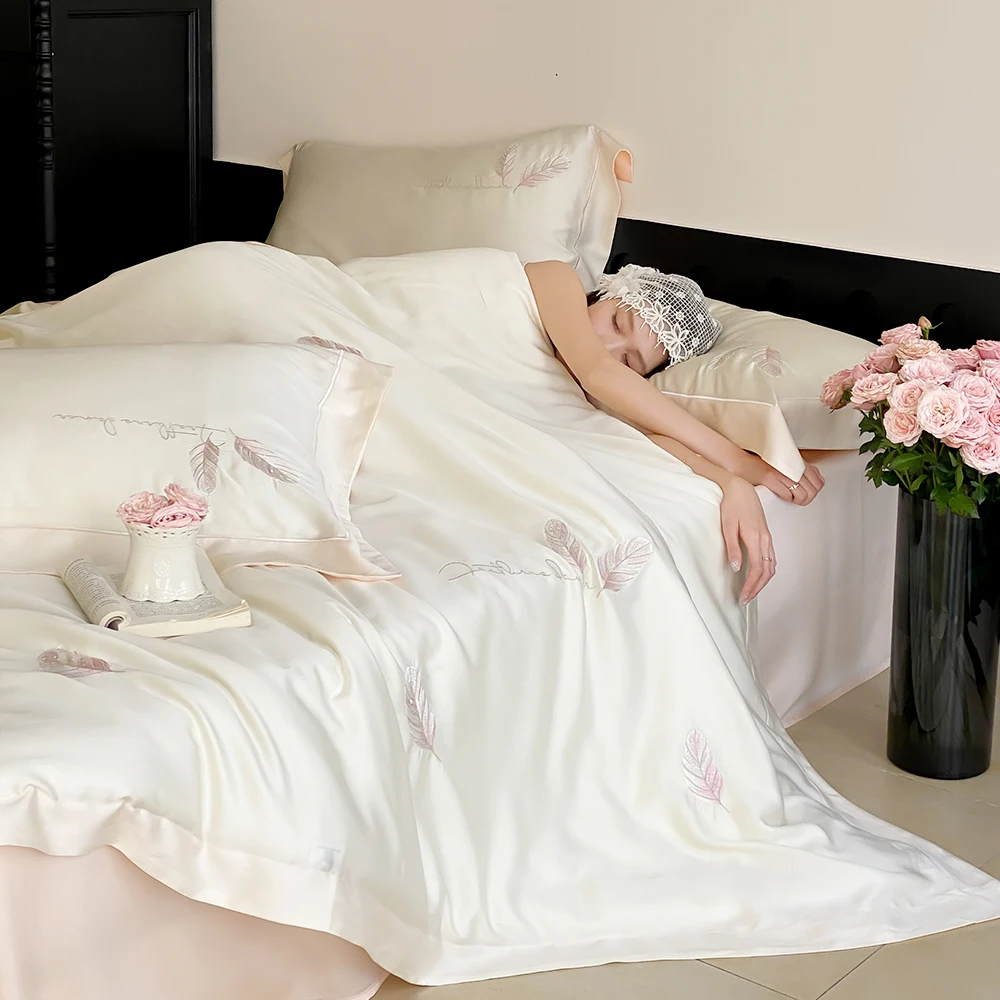
Eczema Relief: How Silk Soothes Atopic Dermatitis
Eczema (atopic dermatitis) presents unique challenges with its inflammatory flare-ups, intense itching, and compromised skin barrier function. For the estimated 15-20% of children and 1-3% of adults who suffer from this condition, fabric choice can significantly impact symptom severity.
Silk offers multiple benefits for eczema-prone skin:
- Friction reduction: Silk’s smooth surface minimizes mechanical irritation that can trigger scratching cycles
- Temperature regulation: Prevents the overheating that commonly triggers nighttime eczema flares
- Moisture balance: Helps maintain skin hydration without creating the dampness that can worsen symptoms
- Allergen resistance: Reduces exposure to dust mites and other triggers that can exacerbate flares
Clinical studies support these benefits, with research showing that silk clothing therapy can reduce eczema severity scores and improve quality of life for sufferers. Many dermatologists now recommend mulberry silk bedding sets as part of a comprehensive eczema management strategy, particularly for those with facial or upper body symptoms.
Full-size Silk Sheets, King Size Silk Sheets, Queen Size Silk Sheets, Twin Size Silk Sheets, Washable Silk Sheets
Price range: $95.95 through $178.37 Select options This product has multiple variants. The options may be chosen on the product page100% Silk Sheets, Green Silk Sheets, King Size Silk Bedding Set, Mulberry Silk Bedding Sets, Queen Size Silk Bedding Set
Price range: $1,246.21 through $1,615.22 Select options This product has multiple variants. The options may be chosen on the product pagePink Silk Sheets, Twin Size Silk Sheets
$171.80 Select options This product has multiple variants. The options may be chosen on the product pageFull-size Silk Sheets, Pink Silk Sheets
$136.31 Select options This product has multiple variants. The options may be chosen on the product pageGrey Silk Sheets, Silk Sheet and Pillowcase Set
Price range: $88.20 through $146.64 Select options This product has multiple variants. The options may be chosen on the product pageBamboo Silk Sheets, Cooling Silk Sheets
Price range: $130.76 through $177.80 Select options This product has multiple variants. The options may be chosen on the product page
Acne Management: Silk’s Role in Clearer Skin
Acne sufferers face a complex relationship between their skin and the fabrics that touch it. Rough fabrics can create micro-tears that trap bacteria, while absorbent materials can strip away beneficial oils and disrupt the skin’s balance.
Silk offers several protective mechanisms for acne-prone skin:
- The smooth surface prevents the micro-abrasions that can trap bacteria and trigger breakouts
- Natural antimicrobial properties reduce bacterial proliferation on fabric surfaces
- Superior breathability helps prevent the sweat and oil buildup that can clog pores
- Balanced absorption keeps skin care products on the face rather than on the pillowcase
These properties directly address the condition known as “acne mechanica”—breakouts caused by friction, pressure, and heat. For many acne sufferers, simply switching to a silk pillowcase results in noticeable improvement within weeks, particularly for side and stomach sleepers whose faces have extended fabric contact.
Rosacea and Redness: Gentle Relief for Reactive Skin
Rosacea affects approximately 16 million Americans, causing facial redness, visible blood vessels, and sometimes small bumps or pustules. This condition is notoriously reactive to triggers including friction, heat, and certain chemicals—all factors that can be minimized with silk.
For rosacea sufferers, silk provides targeted benefits:
- The frictionless surface prevents mechanical stimulation of already-sensitive facial blood vessels
- Temperature regulation helps avoid the heat triggers that cause vasodilation and flushing
- Absence of harsh chemicals prevents direct irritant reactions
- Preservation of skin care medications allows treatments to work effectively overnight
Many dermatologists recommend silk pillowcases as part of a comprehensive rosacea management strategy. The gentle surface is particularly beneficial for the papulopustular subtype of rosacea, which can be aggravated by rough fabrics that irritate existing bumps and pustules.
Combating Dryness: Silk’s Moisture-Preserving Effects
Dry, tight, and flaky skin affects millions of people, either seasonally or chronically. This condition occurs when the skin’s natural moisture barrier becomes compromised, allowing excessive water loss through a process called transepidermal water loss (TEWL).
Silk helps preserve skin hydration through multiple mechanisms:
- It doesn’t aggressively absorb natural oils from the skin like cotton and other materials
- Its temperature-regulating properties prevent the excessive dryness associated with overheating
- The smooth surface reduces the friction that can remove surface skin cells and disrupt the moisture barrier
- It helps preserve applied moisturizers and serums, allowing them to work effectively throughout the night
These benefits are particularly noticeable during winter months when indoor heating creates low-humidity environments that accelerate moisture loss from the skin. Using silk pillowcases and bedding provides a simple yet effective way to reduce this seasonal dryness.
Allergy Management: Minimizing Reactions with Silk
Skin allergies present differently from other sensitive skin conditions but can be equally uncomfortable with itching, hives, and inflammation. Common fabric-related triggers include dust mite allergens, chemical treatments, and fiber particles that can embed in skin.
Silk provides multiple protections for allergy sufferers:
- Natural resistance to dust mites (the primary allergen in bedding)
- Minimal shedding of fiber particles that can irritate skin and airways
- Absence of common chemical irritants found in other fabrics
- Creation of a barrier between skin and other potential allergens
For the estimated 20 million Americans with dust mite allergies, hypoallergenic silk fabric benefits can dramatically reduce symptoms. Studies show silk bedding harbors significantly fewer allergens than conventional options, creating a cleaner sleep environment for both skin and respiratory health.
Natural Silk vs. Other Fabrics: A Comparative Analysis
Understanding how silk compares to other common fabrics helps explain its unique benefits for sensitive skin. Each fabric has distinct properties that affect how it interacts with skin, including texture, breathability, moisture management, allergen resistance, and chemical content.
The following sections provide detailed comparisons between silk and other popular fabric options to help you make informed choices based on your specific skin needs and sensitivities.
Silk vs. Cotton: Natural Fiber Showdown
Both silk and cotton are natural fibers, but they interact with sensitive skin in fundamentally different ways:
| Feature | Silk | Cotton |
|---|---|---|
| Fiber Structure | Long, smooth fibers (up to 900m continuous filament) | Short, hairy fibers (2-3cm length) |
| Surface Texture | Extremely smooth (11 micron diameter) | Relatively rough (20 micron diameter) |
| Moisture Management | Balances absorption (30% of weight) without feeling damp | Highly absorbent (100% of weight), pulls moisture from skin |
| Temperature Regulation | Adapts to body temperature, cooling or warming as needed | Holds heat and moisture, can feel clammy |
| Allergen Retention | Naturally resistant to dust mites and mold | Readily harbors dust mites, pollen, and other allergens |
| Chemical Processing | Minimal processing with natural degumming | Often heavily processed with bleaches, formaldehyde resins |
While cotton remains popular for its affordability and washability, silk offers superior benefits for those with skin sensitivities. The key difference lies in silk’s protein structure versus cotton’s cellulose composition—proteins simply interact more harmoniously with human skin.
Silk vs. Synthetic Fabrics: Natural vs. Man-Made
The differences between silk and synthetic fabrics like polyester or nylon are even more pronounced:
| Feature | Silk | Synthetic Fabrics |
|---|---|---|
| Composition | Natural protein fibers | Petroleum-based polymers |
| Chemical Content | Minimal processing chemicals | Numerous manufacturing chemicals, flame retardants |
| Breathability | Highly breathable, allows air circulation | Limited breathability, can trap heat and moisture |
| Moisture Handling | Wicks moisture away from skin | Often creates moisture barrier, causing sweating |
| Static Electricity | Minimal static generation | High static electricity that can irritate skin |
| Environmental Impact | Biodegradable, renewable resource | Non-biodegradable, petroleum-derived |
For sensitive skin, the chemical composition of synthetic fabrics presents particular challenges. Many contain formaldehyde resins, antimicrobial treatments, and flame retardants that can leach onto skin during the heat and friction of sleep. Silk’s natural composition avoids these potential irritants entirely.
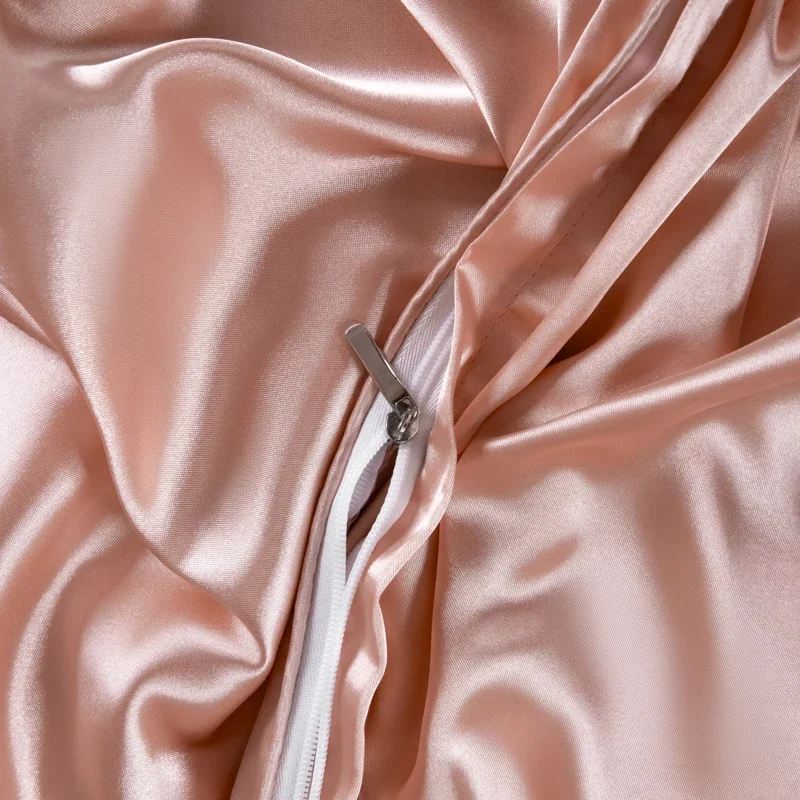
Silk vs. Modern Alternatives: Bamboo and Tencel
Modern eco-friendly fabrics like bamboo and Tencel (lyocell) offer interesting alternatives to traditional options:
| Feature | Silk | Bamboo/Tencel |
|---|---|---|
| Processing | Mechanical unwinding of cocoons with minimal chemicals | Chemical processing of cellulose with solvent recovery |
| Texture | Exceptionally smooth, continuous fibers | Very soft but slightly less smooth than silk |
| Moisture Management | Moderate absorption with excellent release | High absorption with good release |
| Durability | Highly durable with proper care | Good durability, less prone to damage from washing |
| Price Point | Higher investment | More affordable alternative |
For those seeking silk-like benefits at a lower price point, bamboo silk sheets offer a reasonable alternative. While not identical to natural silk in their properties, these modern fabrics do provide good smoothness and moisture management that can benefit certain types of sensitive skin.
Selecting Quality Natural Silk for Sensitive Skin
Not all silk products deliver the same benefits for sensitive skin. Understanding quality indicators helps ensure you receive the full therapeutic potential of this remarkable fabric:
Quality checklist for sensitive skin silk products:
- Silk type: Look for mulberry silk (Bombyx mori), the highest quality variety with the most consistent fibers
- Grade: 6A is the highest grade, indicating minimal defects or inconsistencies
- Momme weight: 19-25 momme provides the optimal balance of durability and softness for bedding
- Certification: OEKO-TEX Standard 100 certification verifies testing for harmful substances
- Weave type: Charmeuse weave provides the smoothest surface for sensitive skin
To verify authentic silk, simple tests include:
- The burn test: Real silk smolders and smells like burning hair (protein), while synthetics melt
- The ring test: Pure silk can be pulled through a wedding ring when bunched up
- The texture test: Genuine silk feels cool and smooth initially, then warms to touch
While quality silk represents a higher investment initially, its durability (lasting 5-10 years with proper care) makes it cost-effective over time, especially considering the skin health benefits.
Caring for Silk to Preserve Its Skin Benefits
Proper care ensures your silk maintains its skin-friendly properties for years to come:
Washing:
– Hand wash with pH-neutral detergent specifically formulated for silk
– Use lukewarm water (never hot)
– Avoid soaking for extended periods
– Rinse thoroughly to remove all detergent residueDrying:
– Never wring or twist silk
– Roll gently in a clean white towel to remove excess moisture
– Air dry away from direct sunlight
– Hang or lay flat depending on the itemStorage:
– Store in a breathable fabric bag, never plastic
– Keep away from direct sunlight which can weaken fibers
– Avoid hanging silk sheets or pillowcases for long periodsCleaning Frequency:
– Pillowcases: Weekly washing is ideal
– Sheets: Every 10-14 days
– Silk garments: After 3-4 wears unless soiled
Following these care guidelines preserves both the luxurious feel and the skin-friendly properties that make silk so beneficial for sensitive skin.
When to Choose Silk: Essential Products for Sensitive Skin
For those new to silk, certain products offer the most significant impact for sensitive skin:
Silk pillowcases – The ideal starting point, providing 7-9 hours of direct facial contact nightly and immediate benefits for facial skin sensitivity
Silk sleepwear – Particularly beneficial for those with body eczema, night sweats, or widespread sensitivity issues
Silk sheets – Create a comprehensive sensitive skin environment, especially valuable for those with widespread skin conditions
Specialized items – Silk hair wraps reduce friction damage to hair and prevent facial irritation, while silk face masks minimize mask-related irritation
For most sensitive skin sufferers, starting with a high-quality pillowcase provides the most noticeable immediate benefits, as the face typically shows sensitivity reactions most visibly and has the most consistent fabric contact during sleep.
Is Natural Silk Worth the Investment? Expert Perspectives
Dermatologists increasingly recommend silk for sensitive skin conditions based on both clinical observations and emerging research:
“The smooth surface of silk reduces the friction that often triggers inflammatory skin conditions,” explains one prominent dermatologist. “For patients with rosacea, eczema, or general sensitivity, switching to silk pillowcases is often one of my first recommendations.”
Scientific evidence supporting silk’s benefits continues to grow. Studies examining silk’s friction coefficient show significant reductions in mechanical irritation compared to other fabrics. Research into sleep-related skin damage also indicates that silk causes fewer sleep wrinkles and less moisture loss than cotton alternatives.
From a cost-benefit perspective, silk represents a worthwhile investment for those with persistent skin sensitivity. While the initial cost exceeds that of conventional fabrics, the durability of quality silk combined with potential reductions in skin care products and treatments often justifies the expense.
The greatest benefits typically appear for those who:
– Experience sensitivity reactions specifically to fabric contact
– Suffer from conditions aggravated by heat and sweating during sleep
– Have allergies to dust mites or other common allergens
– Use nighttime skin treatments that need to remain on the skin rather than transferring to bedding
Why Is Natural Silk the Ultimate Choice for Sensitive Skin?
Natural silk stands unmatched in its ability to support sensitive skin health through its remarkable combination of properties. The five core benefits—exceptional smoothness, hypoallergenic nature, optimal moisture regulation, superior breathability, and natural purity—work together to create an ideal environment for even the most reactive skin.
For specific conditions like eczema, acne, rosacea, and general dryness, silk provides targeted relief by addressing both symptoms and underlying triggers. Its natural structure works in harmony with the skin’s own functions, supporting the moisture barrier and reducing common irritants.
While other fabrics may offer individual benefits, none combines all the protective properties of silk in a single natural material. Modern alternatives may approach some of silk’s characteristics, but its unique protein structure—similar to human skin—creates an unmatched biocompatibility.
Making the transition to silk doesn’t need to happen all at once. Many users report significant improvements by simply starting with a silk pillowcase and gradually expanding their collection as they experience benefits.
For those with sensitive skin, natural silk isn’t just a luxury—it’s a practical investment in daily comfort and long-term skin health. By reducing irritation cycles, supporting natural skin functions, and eliminating common triggers, silk helps create the foundation for healthier, calmer skin.

